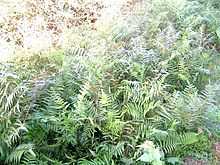Diplazium esculentum
| Diplazium esculentum | |
|---|---|
 | |
| Scientific classification | |
| Kingdom: | Plantae |
| Division: | Pteridophyta |
| Class: | Polypodiopsida |
| Order: | Polypodiales |
| (unranked): | Eupolypods II |
| Family: | Athyriaceae |
| Genus: | Diplazium |
| Species: | D. esculentum |
| Binomial name | |
| Diplazium esculentum (Retz.) Sw. | |
| Synonyms | |
|
Athyrium esculentum | |


Vegetable fern (Diplazium esculentum) is an edible fern found throughout Asia and Oceania. It is probably the most commonly consumed fern.[1] The young fronds are stir-fried as a "vegetable" or used in salads.[2][3]
In Hawaii it is used to make pohole.
Description
It is known as pucuk paku in Malaysia, paco in the Philippines,[2] dhekia (ঢেকীয়া) in Assam "Dhenkir Shaak (ঢেঁকির শাক) in Bengali, and linguda in northern India, referring to the curled fronds. In Thailand it is known as phak khut (Thai: ผักกูด). They may have mild amounts of fern toxins but no major toxic effects are recorded.[4]
Diplazium esculentum is sometimes grown as a house plant.
The genus Diplazium is in the family Athyriaceae, in the eupolypods II clade[5] of the order Polypodiales,[6] in the class Polypodiopsida.[7]
References
- ↑ Anonymous. "Vegetable fern". Use and production of D. esculentum. AVRDC (The World Vegetable Center). Retrieved 27 November 2011.
- ↑ 2.0 2.1 Copeland EB (1942). "Edible Ferns". American Fern Journal 32 (4): 121–126. doi:10.2307/1545216.
- ↑ Ethnobotanical Leaflets
- ↑ Gangwar Neeraj Kumar (2004). "Studies on pathological effects of linguda (Diplazium esculentum, Retz.) in laboratory rats and guinea pigs". Indian Journal of Veterinary Pathology 28 (2).
- ↑ Carl J. Rothfels, Anders Larsson, Li-Yaung Kuo, Petra Korall, Wen- Liang Chiou, Kathleen M. Pryer (2012). "Overcoming Deep Roots, Fast Rates, and Short Internodes to Resolve the Ancient Rapid Radiation of Eupolypod II Ferns". Systematic Biology 61 (1): 70.
- ↑ Maarten J. M. Christenhusz, Xian-Chun Zhang & Harald Schneider (2011). "A linear sequence of extant families and genera of lycophytes and ferns". Phytotaxa 19: 7–54.
- ↑ Alan R. Smith, Kathleen M. Pryer, Eric Schuettpelz, Petra Korall, Harald Schneider & Paul G. Wolf (2006). "A classification for extant ferns". Taxon 55 (3): 705–731. doi:10.2307/25065646.